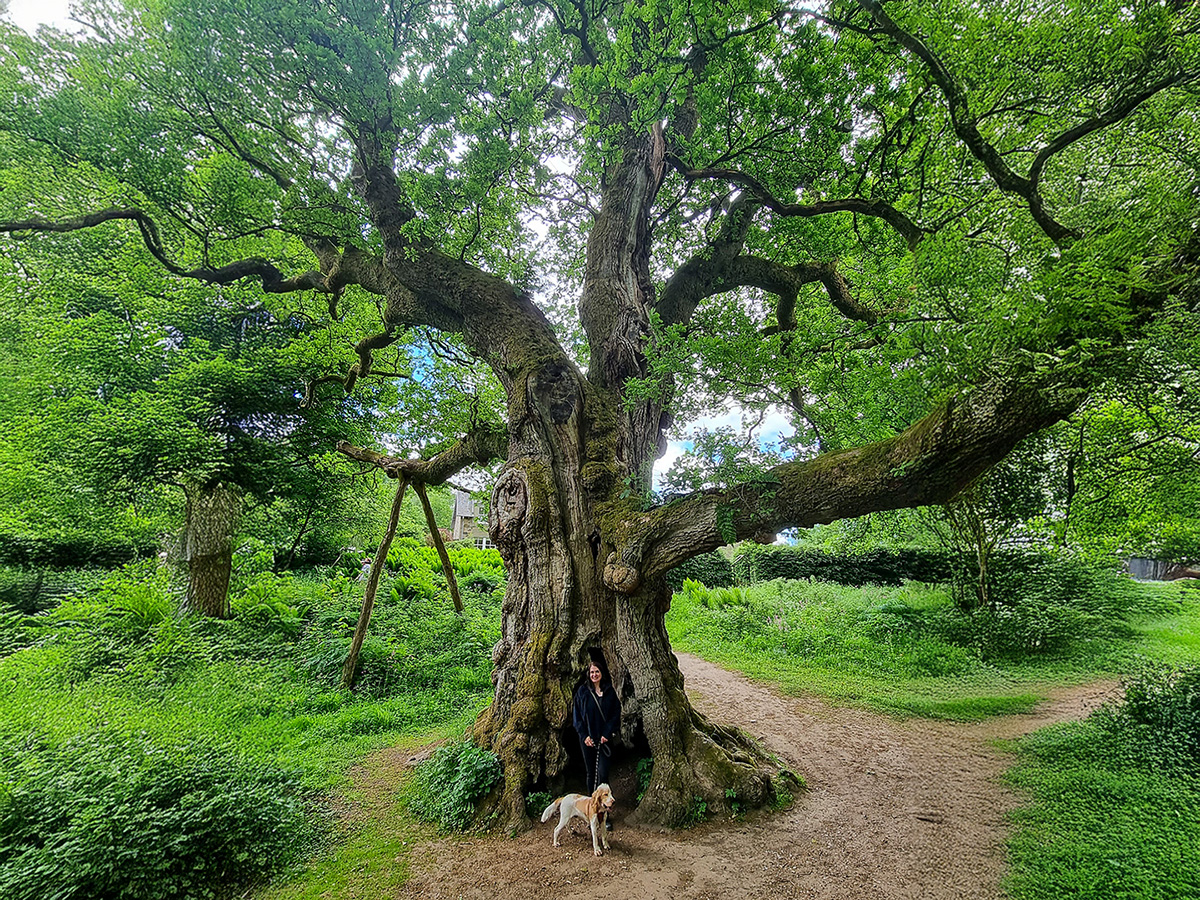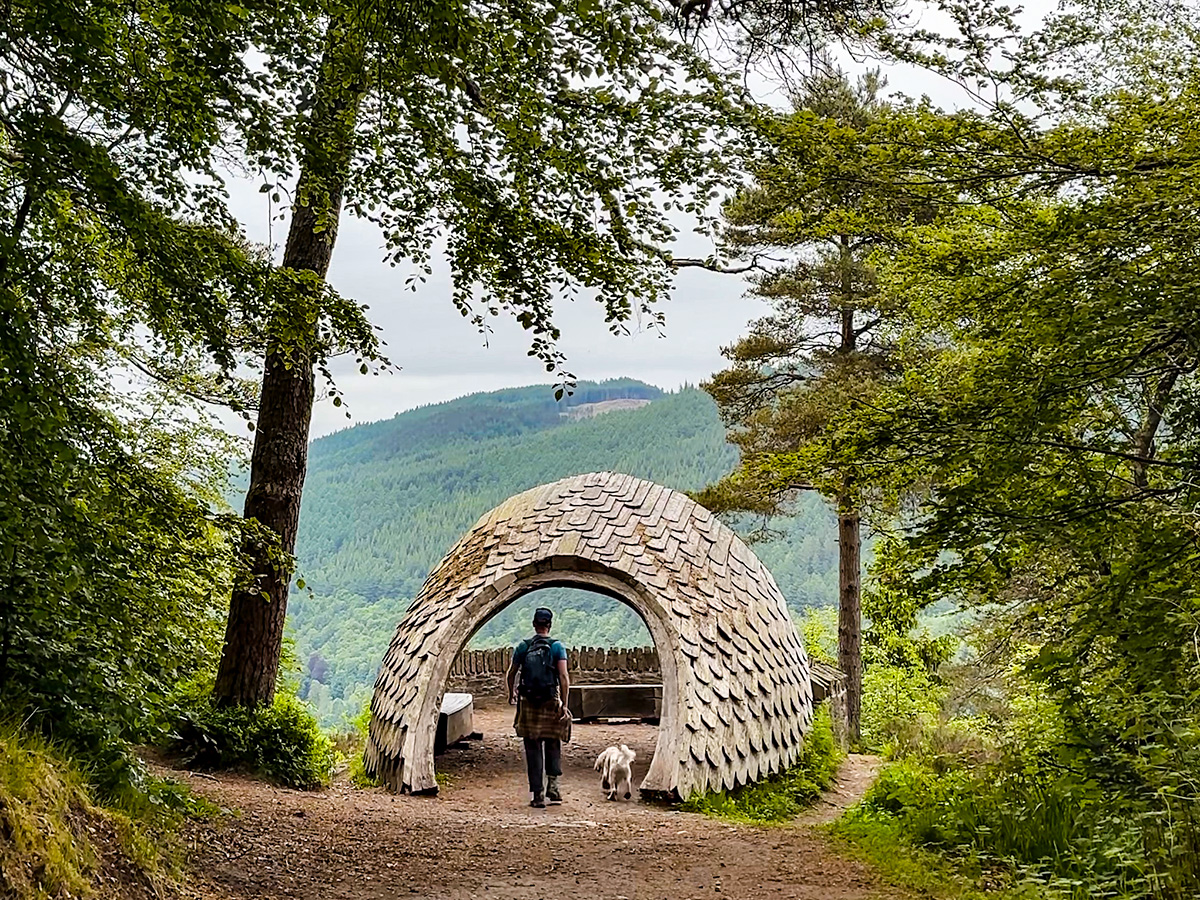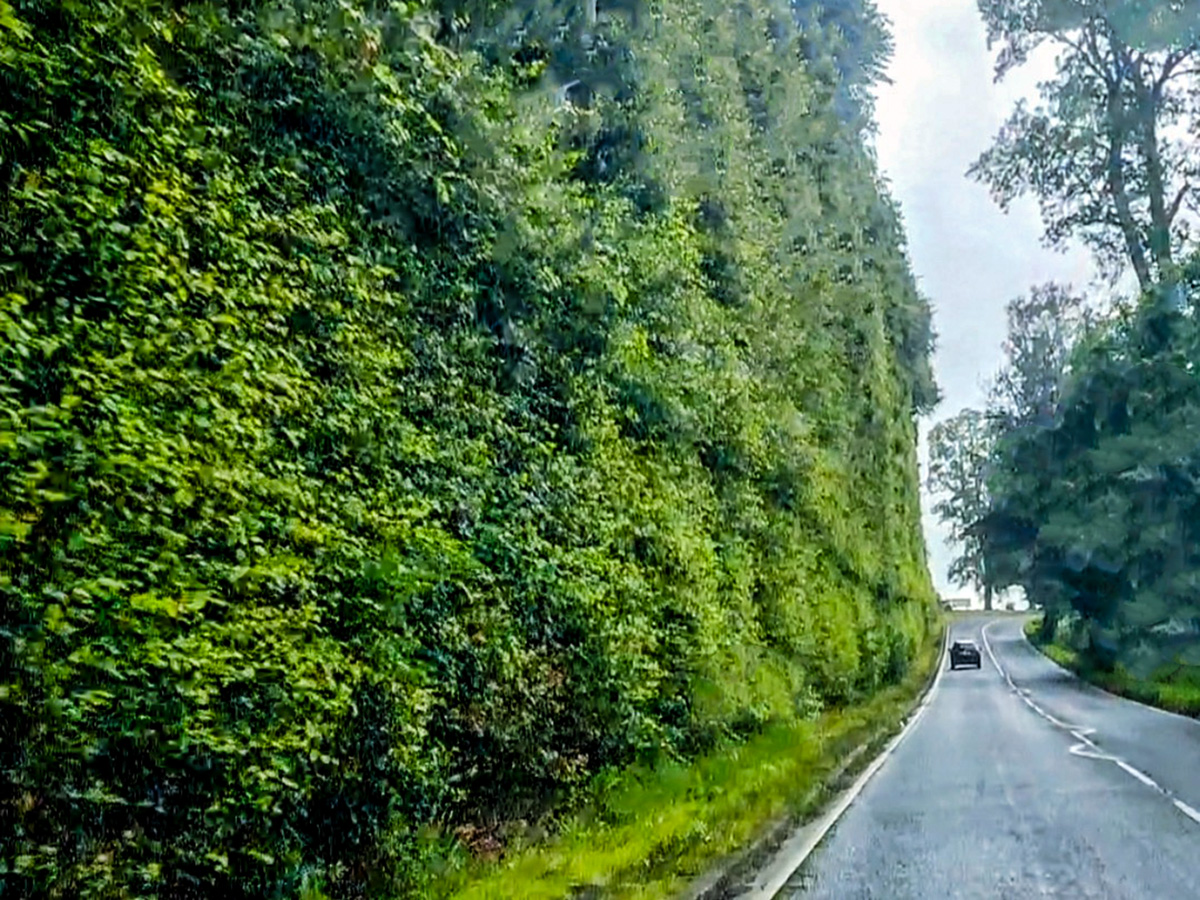Scotland is renowned for its ancient history – castles, stone circles, brochs – and the people who built them. But some of Scotland’s most ancient residents are far older than the Picts, Scots or Clans.
Scattered across the Highlands and Lowlands are Scotland’s ancient trees – and they have a story or two to tell.
From reformation to Roman governors to Shakespear, Scotland’s veteran trees have long played a central role in Scotland’s stories and history.
Here is how to visit my favourite oldest trees in Scotland.

The Birnam Oak – the downfall of Macbeth
> Location: Birnam, Perthshire
> Age: 500+ years
Believed to be the last tree from Shakespeare’s Birnam Wood, The Birnam Oak and its neighbour the Birnam Sycamore are the sole surviving trees of a huge forest that once covered this area.
In Shakespear’s Scottish Play, the Birnam Woods hid the armies advancing against Macbeth – the soldiers were said to have each cut down a branch from the wood to hide themselves, making it look like the wood was moving toward’s Macbeth’s castle.
Macbeth was ultimately defeated by the army, fulfilling the prophecy set by the Weird Sisters hat Macbeth will be King of Scotland until Birnam Wood arrived at his castle Dunsinane…
> How to visit: From the centre of Dunkeld, cross over the Telford Bridge and take the stairs down to the banks of the River Tay. You can find the Birnam Oak around a 10 minute walk from the centre of Dunkeld along the river.
> Stay at: The Taybank Hotel just across the river from the Birnam Oak
> Read more: How to visit Dunkeld
The Fortingall Yew – the oldest tree in the world?
> Location: Fortingall, Perthshire
> Age: 2,000–5,000 years old
Did you know that Europe’s oldest tree is in Scotland?
Hidden away in al churchyard in Perthshire, the Fortingall Yew is believed to be between 2,000 and 5,000 years old – that is older than the Roman Empire and Skara Brae on Orkney!
In fact, if the tree is actually 5000 years old, then it one of the oldest living things on earth.
One of the most popular stories about the Fortingall Yew claims that Pontius Pilate, the Roman governor linked to Jesus’ crucifixion, was born nearby and actually played under the tree as a child.
It was said that Pontinus was actually of Scottish ancestry and was actually the son of a Caledonian woman conceived during his father’s visit to Scotland.
Did you know that the Fortingall Yew is reportedly changing sex? This male tree has started producing female berries, a rare phenomenon in yews, possibly triggered by its incredibly ancient age.
> How to visit: The Fortingall Yew is located in the church yard at Fortingall in Highland Perthshire.
> Where to stay: Go for all out luxury at the brand new Fortingall Hotel, stay at the lovely Salmon House, or the thatched Glen Croft.
The Capon Tree – death to the Turnball clan
> Location: Jedburgh, Scottish Borders
> Age: 1000+ years
This mighty sessile oak is one of the oldest trees in Scotland and one of the last remnants of the ancient Jedforest in the Scottish Borders.
With a trunk circumference over 10.5m / 17 feet, the Capon Tree is steeped in legend and is said to have once sheltered Scottish clans during times of war. Today, it’s a one of the protected heritage trees of Scotland.
Taking its name from the gets its name from the Capuchin monks of Jedburgh Abbey, the Capon Tree is now over 1,000 years old and its trunk is now twisted and split, reinforced with concrete, bricks, and timber supports.
Historically, the Capon Tree was linked to waring and thieving (called reiving) between the Border clans, including the infamous Turnbulls.
In order to prevent the Turnballs from stealing from their neighbours quite so much, King James IV ordered the hanging of every tenth Turnball – and its said that the Capon Tree was used for the purpose.
Today, the Capon Tree plays a ceremonial role in Jedburgh’s annual Jethart Callant’s Festival where, for the past 75+ years, a sprig from the tree is affixed to the festival Callant’s lapel.
How to visit: Follow route 8 of the walks around Jedburgh (PDF)
Stay at: The Capon Tree Townhouse in Jedburgh

Dunkeld’s Parent Larch – the birth of Scottish forestry
> Location: Dunkeld
> Age: Planted in 1738
The first larch planted in Scotland, this tree gave rise to the widespread use of larch in Scottish reforestation – and kicked off commercial forestry in Scotland.
Of the original five European larches imported from the Tyrol Mountains, the Dunkeld Parent Larch is the sole survivor.
Located within the grounds of what is today the Dunkeld House Hotel , it served as the seed source for an enormous wave of planting initiated by the Dukes of Atholl across Perthshire in the 18th and 19th centuries, contributing to the planting of an estimated 14 million larches across the region.
> How to visit: you can find the Dunkeld Parent Larch along the Larch Walk, part of the Dunkeld and Birnam way‑marked Fiddler’s Path walks, which follows the banks of the River Tay and winds past the cathedral.
> Stay at: The Dunkeld House Hotel
> Read more: How to visit Dunkeld
One of the best ways to see larches in Perthshire is from the Pine Cone Point viewpoint above Dunkeld.
The Meikleour Beech Hedge – in memory of the Jacobites
> Location: Near the village of Meikleour, Blairgowrie
> Age: Planted in 1745
Though technically a hedge, the Meikleour Beech Hedge consists of towering beech trees over 100 feet tall, planted in memory of Jacobite soldiers.
The owner of the hedge, and the ancestors of the current owners, Robert Murray Nairne, was killed at Culloden – and the hedge is a dramatic memorial to all those lost.
The Meikleour hedge is the tallest and longest hedge in the world and one of Scotland’s (and possibly the world’s) greatest wonders.
> How to visit: The Meikleour Hedge is just to the south of the village of Meikleour, you can’t really miss it.
> Stay at: the Meikleour Arms Hotel

Niel Gow’s Oak – music and legend under the branches
> Location: Inver, Dunkeld
> Age: 300+ years
Niel Gow’s Oak is an ancient oak tree located near Dunkeld in Perthshire, Scotland. It is famously associated with Niel Gow (1727–1807), one of Scotland’s most celebrated fiddlers and composers of traditional Scottish music.
Gow composed many of his tunes while sitting beneath this tree, overlooking the River Tay. The oak is several hundred years old and has become a cultural landmark, drawing visitors and musicians alike.
A commemorative plaque nearby honours Gow’s contribution to Scottish fiddle music and his connection to the site. Underneath the tree is a bench, inscribed “I’ll sit beneath the fiddle tree, with the ghost of Niel Gow next to me.”
> How to visit: Follow the ‘Fiddler’s Path‘ from Dunkeld
> Stay at: The Taybank Hotel just across the river from the Birnam Oak
> Read more: How to visit Dunkeld

The Covenanter’s Tree – religeon punishable by death
> Location: Airdrie
> Age: 300–400 years
One used as a meeting place for secret Covenanter worship in the 17th century, the Covenanter’s Oak, is located on the Dalzell Estate near Motherwell.
Planted by King David I (r. 1124–1153) as part of a royal deer park it was most famously used during the 1660s “Killing Times” by Covenanters to gather under its canopy for forbidden outdoor worship services.
Did you know that the Conventors refused to believe that the monarch was the head of the church – and had signed a National Covenant in 1638 in opposition to the Stuart King’s interference in the
Church of Scotland? Worshiping as a conventor was punishable by death…
> How to visit: Explore the Dalzell Estate near Motherwell to visit the Conventors Tree
> Stay at: The Motherwell Moorings Hotel
The Great Yew of Ormiston – trysts and reformation
> Location: Ormiston, East Lothian
> Age: 1000+ years old
The Great Yew of Ormiston, located in the former grounds of Ormiston Hall, is one of Scotland’s oldest and one of the most historically significant and oldest trees in Scotland.
Estimated to be over 1,000 years old, it is a rare layering yew, where branches root to form new trunks around a central core.
Otherwise known as the Cathedral Yew, the Ormiston Yew is one of the oldest trees in Scotland and is associated with the Scottish Reformation, where Scotland established its own protestant church, with reformer John Knox said to have preached beneath it.
The Great Yew of Ormiston is also known as a “trysting tree,” where locals convened for important meetings – or romantic encounters.
> How to visit: The tree is in the grounds of the old Ormiston Hall.
> Stay at: The Dalhousie Castle Hotel
You might also like: Scotland’s best forest walks
The oldest trees in Scotland – FAQs
Q: What is the oldest tree in Scotland?
A: The Fortingall Yew in Perthshire is believed to be Scotland’s oldest tree, possibly over 5,000 years old.
Q: Where can I find ancient yew trees in Scotland?
A: Visit Fortingall, Craigends, and Clachan for ancient yews that are centuries—if not millennia—old.
Q: Which are the oldest trees in Scotland?
A: The Fortingall Yew (5000 years) the Beauly Priory Elm, Inverness (800 years), the Birnham Oak (500 years) Capon Tree, Jedburgh (1000 years old)
Q: What are Scotland heritage trees?
A: These are trees recognized for their cultural, historical, or ecological value, protected by the Woodland Trust and other organizations.
Q: Are there oak trees in Scotland over 500 years old?
A: Yes, trees like the Capon Tree, Birnam Oak, and Kilmahog Oak are all more than 500 years old.
What is the Birnam Oak, and why is it famous?
A: The Birnam Oak is a 500-year-old tree believed to be the last living remnant of Birnam Wood, made famous by Shakespeare’s Macbeth.
Q: Can I visit the Fortingall Yew?
A: Yes, the Fortingall Yew is located in a churchyard in Fortingall, Perthshire. It’s open to the public and protected by a stone wall to prevent damage to one of the oldest trees in Scotland.
Q: What is layering in yew trees?
A: Layering is a process where a tree’s branches touch the ground and take root, forming a new trunk. The Craigends Yew is a famous example.
Q: Which trees in Scotland are connected to folklore or legends?
A: The Wallace Oak, Birnam Oak, and Fortingall Yew are all tied to Scottish legends, including William Wallace and Macbeth.
Q: Are any of these ancient trees protected?
A: Yes, many of these trees are designated as heritage trees by conservation organizations and are protected due to their ecological and historical importance.
Q: What is “Big Tree Country” in Scotland?
A: “Big Tree Country” refers to Highland Perthshire, an area known for its dense collection of ancient and monumental trees, including larches, oaks, and yews and many of the oldest trees in Scotland.
Which is your favourite of the oldest trees in Scotland?
Love from Scotland x
